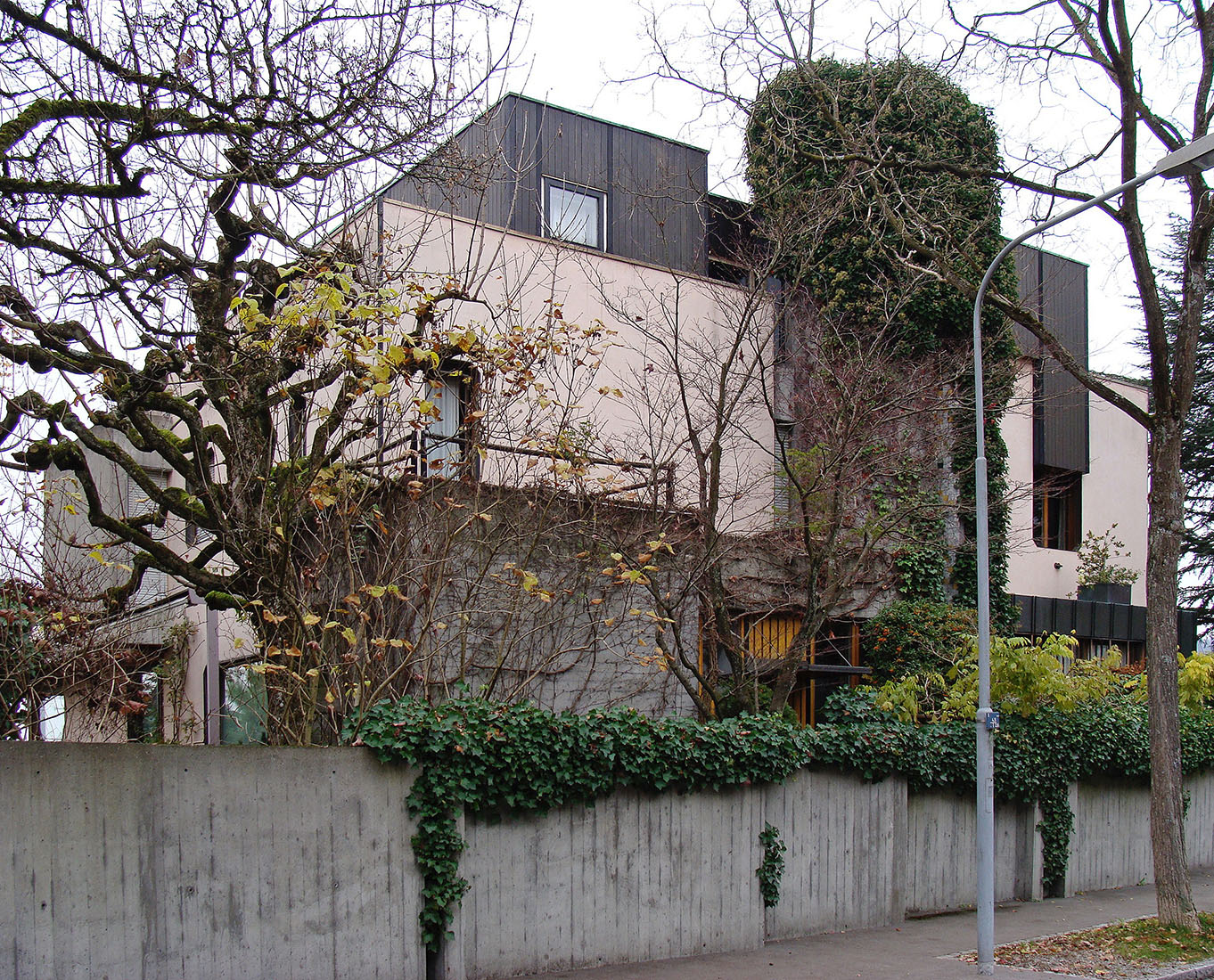 |
 |
 |
 |


Zentner House
Aurora Strasse, Zurich
1964
In 1964 Carlo Scarpa was commissioned with the renovation of a pre-1914 villa in Zurich. The wife of the client was an old acquaintance of Carlo Scarpa, originating from Venice. The villa in neo-rococo style is located in a sloping terrain near the lakeside in Zurich. The building restrictions allowed only minor changes to the external walls. Scarpa was forced to maintain the perimeter alignment along the street front. On the three restricted sides to the north, east and west Carlo Scarpa enclosed the building within compact volumes. Hence he concentrated his remodeling on the remaining side, facing the south. This elevation of the villa is conceived as a dynamic composition, contrasting with the street front. Horizontal volumes are arranged on the southern elevation, stepped back to create terraces overlooking the vast garden. The appearance of the south façade is marked by the large protruding eaves and the pergola suspended below them and the concrete balcony, which protrudes out into the garden. The living room, which is related to the mentioned balcony, features a beautiful parquet floor. In the interior the dining room, considered to be an indoor balcony, projects into the atrium as a response to the balcony jutting out to the garden. The design by Carlo Scarpa emphasizes the continuity and fluidity of the garden and the indoor space. The individual architectural elements tend to accentuate the relationship between the interior space and the exterior envelope of the villa. An elevator, featuring a shaft of ellipsoid cross-section made of glass block, was integrated into the building. The use of glass block remembers the Venetian mosaic. The interiors are furnished with some fine individual pieces, like the long and narrow dining table designed by Carlo Scarpa. This table is inlad with stone fragments in a variety of colors, according to the owner, these stones were collected by Carlo Scarpa himself. A bar cabinet and the arrangement of the client's art collection are further features to be mentioned.
Im Jahr 1964 wurde Carlo Scarpa mit der Renovierung einer rund 50jährigen Villa in Zürich beauftragt. Die Frau des Auftraggebers war eine alte Bekannte von Carlo Scarpa und stammte aus Venedig. Die Villa im Neo-Rokoko-Stil befindet sich in an einem Hang in der Nähe des Zürichseess. Das Baugesetz erlaubte nur geringfügige Änderungen am Äusseren. Scarpa war gezwungen, die Perimeter Umfassung entlang der Strassenfront zu erhalten. Auf den drei von den Einschränkungen betroffenen Seiten im Norden, Osten und Westen umfasste Carlo Scarpa das Gebäude durch kompakte Volumen. Konsequenterweise konzentrierte er seinen Umbau auf die verbleibende, südliche Seite. Diese Fassade der Villa ist als dynamische Komposition konzipiert, kontrastierend mit der Strassenfront. Die Anordnung von horizontale Volumen an der Südfassade bildet durch die Abstufungen Terrassen mit blick auf den grosszügigen Garten. Die Erscheinung der Südfassade wird geprägt von der grossen vorstehenden Traufe und der Pergola darunter sowie dem Beton Balkon, welcher in den Garten hinausragt. Das Wohnzimmer, verbunden mit dem erwähnten Balkon, verfügt über einen schönen Parkettboden. Im Inneren ragt der Essraum, welcher als ein Indoor-Balkon zu betrachten ist, in das Atrium hinein, und bildet die Reaktion auf den Balkon zum Garten. Der Entwurf von Carlo Scarpa betont die Kontinuität und den Raumfluss von Garten und Innenraum. Die einzelnen Elemente der Architektur neigen dazu, die Beziehung zwischen dem Innenraum und der äusseren Hülle des Hauses zu akzentuieren. Ein Aufzug mit einem Schacht von ellipsoidem Querschnitt aus Glasbausteinen, wurde in das Gebäude integriert. Die Verwendung von Glasbausteinen erinnert an venezianisches Mosaik. Die Innenräume sind mit einigen feinen Einzelstücken eingerichtet, so zum Beispiel dem langen und schmalen Tisch von Carlo Scarpa. Dieser Tisch wird ausgezeichnet durch Intarsien aus Steinfragmenten unterschiedlicher Farbe, welche gemäss dem Besitzer von Carlo Scarpa selbst gesammelt wurden. Als weitere Merkmale sind das Bar-Möbel und die Anordnung der Kunstsammlung des Kunden bemerkenswert.